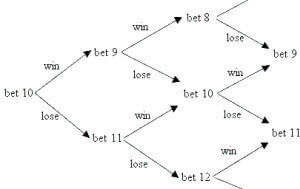D’Alembert System
The D’Alembert roulette system has some aspects in common with the Martingale strategy, although there are some important differences, most notably that it is far less risky than the Martingale. It was named after the eighteenth century Frenchman Jean le Rond d’Alembert, a polymath who was a mathematician, musician, physicist and philosopher. The D’Alembert System derived from one of his theories on probability: that the likelihood of a coin landing on heads increased for each time that it landed on tails. While the original theory was incorrect, the roulette strategy that bears his name has had an enduring popularity.
By Adiela de Bruyn - Last modified 2024/02/08 - Estimated reading time: 3 minutes.
Table of contents

How Does The System Work?
The D’Alembert roulette system is based around betting on binary outcomes, such as red/black, even/odd and 1-18/19-36. It depends for its success on the assumption that in the long term, the frequency of these even-money occurrences will always balance out.
To employ the D’Alembert system, you start by making a small bet on one of the binary options mentioned above. If the bet wins, you continue to make the same bet. If it loses, you increase the size of your next bet by the size of the original stake and continue to do so until you win. In the long term, the theory is that you will end up at your original bet and will have made a profit.
For example, let’s say you start by backing Red with R10. If this bet wins, you will make the same bet on the next spin. If the R10 bet loses, you increase the stake on your next bet to R20, and then R30 and so on. As soon as you get a winner, you reduce the stake on your next bet by R10 and continue in that manner.
Pros and Cons
Unlike the Martingale Strategy, with which this system has some common features, the bet size in the D’Alembert increases relatively slowly. While this means that a winning bet will not cover all the preceding losses, it does mean that the size of your stake will not rise rapidly to consume a large proportion of your betting bank. As a result, it minimizing the rate at which you will lose money and so has the potential to run much longer than riskier strategies.
Although it is less risky than the Martingale, there are some potential disadvantages with the D’Alembert strategy. For a start, the theory upon which it is based may be true, but that isn’t always of practical use. The frequency of binary bets such as heads/tails does balance out in the long term, but only in the very long term, over thousands of bets, and it may not do so during one casino session. As with all roulette systems of this type, there is a danger that the size of the stake you are required to put on each bet grows so large during a losing that it either takes out a significant part of your betting bank or breaches the table limit.
This is why it is important that if you use the D’Alembert System, you make sure that your initial bet size is relatively small, and that you have enough money in your bankroll to ride out the losing runs. If you take these precautions, the system can be an effective way to minimize losses and produce a steady flow of winning bets.







